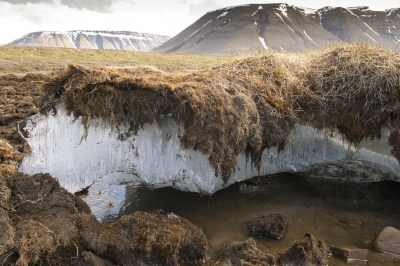
Siberia’s mysterious craters
In July 2020, a Russian TV crew flying over the Yamal peninsula in Siberia spotted a huge crater at least 160 feet deep and 65 feet wide. Scientists who went to investigate it found chunks of ice and rock thrown hundreds of metres away from the epicentre. This crater is just the 17h discovered in the Siberian Arctic, after the first one in 2014. Are they the result of a meteorite strike, a missile blast, permafrost or simply land cave-ins? So far, it remains unclear. But scientists have come up with their theories.
Permafrost make-up two-thirds of Sibera. It is nothing but soil that has remained frozen for years or centuries under topsoil. It contains carbon-rich organic matter, including the remains of plants and animals that died and froze without decaying.
Permafrost covers about 24% of the exposed landmass of the Northern Hemisphere – parts of Siberia, the Tibetan Plateau, Alaska, Northern Canada, Greenland, and parts of Scandinavia.
What do scientists say?
Result of cryovolcanism
In 2018, scientists proposed that the blasts are a form of cryovolcanism, in which eruptions spew out frosty mud or slush rather than molten rocks. Scientists believe the craters form from blasts of methane and carbon dioxide gas trapped within the Siberian permafrost.
How does it work? Natural gas abounds in western Siberia, and some of it likely percolates up along cracks and porous zones in the ground into the mushy layer called taliks, under pressure. (Taliks are surrounded by permafrost). The gas accumulation also comes from methane or carbon dioxide that microbes release after consuming the organic matter in the permafrost. It is either because of the mounting gaseous pressure or the destabilisation of the overlying ice cap that the system explodes, spewing the slurry across the surface and leaving a steep crater behind.
Rising temperature, thawing permafrost
The other reason could be the instability of permafrost, say scientists. Temperature at the Arctic has been significantly rising. In fact, this year, the small town of Verkhoyansk, Russia, reached a scorching 100.4 degrees Fahrenheit.
Rising temperature causes permafrost to thaw, triggering massive changes in the region’s landscape and ecology. Scientists observe that every summer, the thawing has been intensifying.
When frozen-solid, melts, it can collapse in many ways, creating landslides, lakes, pits and even underground tunnels. It may also contribute to more frequent blasts and formation of craters.
Picture Credit : Google




